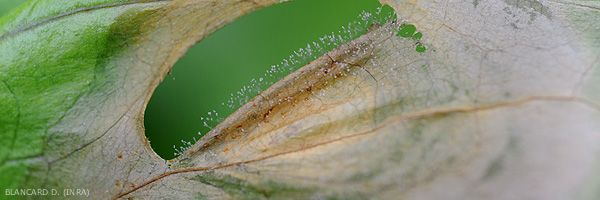
Botrytis cinerea Pers. (1794)
Gray mold
- classification : Fungi, Ascomycota, Leotiomycetes, Leotiomycetidae, Helotiales, Sclerotiniaceae
- téléomorphe : Botryotinia
- English names: Gray mold , Botrytis leaf spot
- téléomorphe : Botryotinia
- English names: Gray mold , Botrytis leaf spot
Botrytis cinerea is a ubiquitous and very polyphagous fungus which is observed practically in all salad production areas in the world (China, Korea, Japan, India, USA, Europe: Germany, Italy, Netherlands, Spain ... ). It can rage alone and cause significant damage, especially under shelters. It is more often reported as part of the parasitic complex of the lower leaves and the crown of the salad, this in particular in association with Sclerotinia sclerotiorum and Sclerotinia minor (Italy, China, Canada, Germany in the Hubei region). Depending on the country and the plots, this resort may vary. Given its biological characteristics, it mainly affects autumn and winter crops.
In France , the situation is roughly comparable. is found Botrytis cinerea both in the open field and under shelters . In the latter, the attacks are often more severe. This is in part due to the nature of the tissues of the plants produced which are more tender and succulent. In addition, in the shelters, the plants grow in an environment which is often more humid, which favors the development of Botrytis cinerea . Although observed from time to time in nurseries, it is after planting, but especially from the head, that this fungus will develop and become more difficult to control. It is a key step in the salad cycle. Indeed, it is at this moment that the vegetation will close, in other words that the plants now well developed and spread out will completely cover the ground. The old leaves, covered by the younger ones, will receive much less light and will be more or less compacted against the ground. They will rather quickly become chlorotic and senescent and remain permanently humid due to the lack of aeration of the collar of the plants at this stage of the culture. Let's not forget, Botrytis cinerea is an fungus opportunistic , which colonizes weakened tissues more easily. The old leaves (also senescent floral parts) constitute nutritional bases very favorable to its installation on salads.
Damage is sometimes observed after harvest, during storage; the few affected salads initiate rots in the crates.
The biological variability of this fungus is not well known. Of strains resistant to several fungicides from different chemical families are known (Dicarboximides, Cyclic imides ...). Recent work in molecular biology has revealed great genetic variability within the species Botrytis cinerea .
In France , the situation is roughly comparable. is found Botrytis cinerea both in the open field and under shelters . In the latter, the attacks are often more severe. This is in part due to the nature of the tissues of the plants produced which are more tender and succulent. In addition, in the shelters, the plants grow in an environment which is often more humid, which favors the development of Botrytis cinerea . Although observed from time to time in nurseries, it is after planting, but especially from the head, that this fungus will develop and become more difficult to control. It is a key step in the salad cycle. Indeed, it is at this moment that the vegetation will close, in other words that the plants now well developed and spread out will completely cover the ground. The old leaves, covered by the younger ones, will receive much less light and will be more or less compacted against the ground. They will rather quickly become chlorotic and senescent and remain permanently humid due to the lack of aeration of the collar of the plants at this stage of the culture. Let's not forget, Botrytis cinerea is an fungus opportunistic , which colonizes weakened tissues more easily. The old leaves (also senescent floral parts) constitute nutritional bases very favorable to its installation on salads.
Damage is sometimes observed after harvest, during storage; the few affected salads initiate rots in the crates.
The biological variability of this fungus is not well known. Of strains resistant to several fungicides from different chemical families are known (Dicarboximides, Cyclic imides ...). Recent work in molecular biology has revealed great genetic variability within the species Botrytis cinerea .





